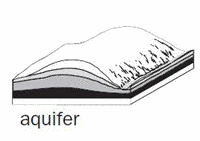aquifer
(redirected from Aquifers)Also found in: Thesaurus, Medical, Encyclopedia.
aq·ui·fer
(ăk′wə-fər, ä′kwə-)n.
An underground layer of permeable rock, sediment, or soil that yields water. Aquifers can range from a few square kilometers to thousands of square kilometers in size.
American Heritage® Dictionary of the English Language, Fifth Edition. Copyright © 2016 by Houghton Mifflin Harcourt Publishing Company. Published by Houghton Mifflin Harcourt Publishing Company. All rights reserved.
aquifer
(ˈækwɪfə)n
(Geological Science) a porous deposit of rock, such as a sandstone, containing water that can be used to supply wells
Collins English Dictionary – Complete and Unabridged, 12th Edition 2014 © HarperCollins Publishers 1991, 1994, 1998, 2000, 2003, 2006, 2007, 2009, 2011, 2014
aq•ui•fer
(ˈæk wə fər)n.
a geological formation of permeable rock, gravel, or sand containing or conducting groundwater, esp. one that supplies the water for wells, springs, etc.
Random House Kernerman Webster's College Dictionary, © 2010 K Dictionaries Ltd. Copyright 2005, 1997, 1991 by Random House, Inc. All rights reserved.
aq·ui·fer
(ăk′wə-fər) An underground layer of sand, gravel, or porous rock that collects water and holds it like a sponge. Much of the water we use is obtained by drilling wells into aquifers.
The American Heritage® Student Science Dictionary, Second Edition. Copyright © 2014 by Houghton Mifflin Harcourt Publishing Company. Published by Houghton Mifflin Harcourt Publishing Company. All rights reserved.
aquifer
A water-bearing, permeable, and porous rock mass or layer.
Dictionary of Unfamiliar Words by Diagram Group Copyright © 2008 by Diagram Visual Information Limited
ThesaurusAntonymsRelated WordsSynonymsLegend:
Switch to new thesaurus
| Noun | 1. | aquifer - underground bed or layer yielding ground water for wells and springs etc geological formation, formation - (geology) the geological features of the earth |
Based on WordNet 3.0, Farlex clipart collection. © 2003-2012 Princeton University, Farlex Inc.
Translations
aquifer
akifer
Collins Spanish Dictionary - Complete and Unabridged 8th Edition 2005 © William Collins Sons & Co. Ltd. 1971, 1988 © HarperCollins Publishers 1992, 1993, 1996, 1997, 2000, 2003, 2005
Collins English/French Electronic Resource. © HarperCollins Publishers 2005
Collins Italian Dictionary 1st Edition © HarperCollins Publishers 1995
